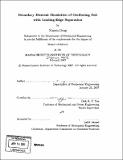| dc.contributor.advisor | Dick K.P. Yue. | en_US |
| dc.contributor.author | Dong, Xiaoxia, S.M. Massachusetts Institute of Technology | en_US |
| dc.contributor.other | Massachusetts Institute of Technology. Dept. of Mechanical Engineering. | en_US |
| dc.date.accessioned | 2007-08-29T20:47:47Z | |
| dc.date.available | 2007-08-29T20:47:47Z | |
| dc.date.copyright | 2007 | en_US |
| dc.date.issued | 2007 | en_US |
| dc.identifier.uri | http://hdl.handle.net/1721.1/38711 | |
| dc.description | Thesis (S.M.)--Massachusetts Institute of Technology, Dept. of Mechanical Engineering, 2007. | en_US |
| dc.description | Includes bibliographical references (leaves 107-110). | en_US |
| dc.description.abstract | In this thesis, we develop a numerical model to account for the leading-edge separation for the boundary element simulation of the oscillating foil with potential flow assumption. Similar to the trailing-edge separation, the leading-edge separation is modeled by a thin shear layer. Because the leading edge is rounded which is different from the sharp trailing edge, the location for leading-edge separation is extremely difficult to predetermine especially when the flow is unsteady. For unsteady flows, the position of the leading-edge separation may vary with time. However, we present a criterion that is related to the adverse pressure gradient to predict the location for the leading-edge separation. Because of the Lagrange scheme of the wake relaxation in the boundary element simulation, the leading-edge wake sheet goes into or through the thin foil easily. In order to solve the problem of the wake penetration into the foil, we present an algorithm to deal with the penetration of the leading-edge wake into the foil body. We simulate the oscillating foil in heaving-pitching motions with our leading-edge model by the boundary element method to compare with the experiments. | en_US |
| dc.description.abstract | (cont.) Without accounting for leading-edge separation, the predictions of the thrust coefficient and the propulsion efficiency of a heaving-pitching foil are good only when the Strouhal number or the maximum angle of attack is small. With our model of the leading-edge separation, the predictions are improved significantly at a larger range of Strouhal numbers or maximum angles of attack because leading-edge separation becomes significant at large Strouhal numbers or maximum angles of attack. Further possible improvements of this leading-edge separation model are discussed. | en_US |
| dc.description.statementofresponsibility | by Xiaoxia Dong. | en_US |
| dc.format.extent | 110 leaves | en_US |
| dc.language.iso | eng | en_US |
| dc.publisher | Massachusetts Institute of Technology | en_US |
| dc.rights | M.I.T. theses are protected by copyright. They may be viewed from this source for any purpose, but reproduction or distribution in any format is prohibited without written permission. See provided URL for inquiries about permission. | en_US |
| dc.rights.uri | http://dspace.mit.edu/handle/1721.1/7582 | |
| dc.subject | Mechanical Engineering. | en_US |
| dc.title | Boundary element simulation of oscillating foil with leading-edge separation | en_US |
| dc.type | Thesis | en_US |
| dc.description.degree | S.M. | en_US |
| dc.contributor.department | Massachusetts Institute of Technology. Department of Mechanical Engineering | |
| dc.identifier.oclc | 166145589 | en_US |
